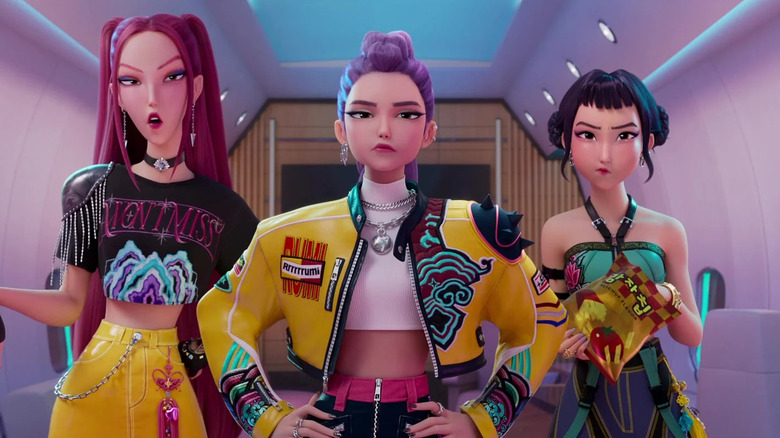Netflix's KPop Demon Hunters Was Completely Changed By This Beloved Marvel Movie
"Spider-Man: Into the Spider-Verse" changed the game for animation. In fact, it's already cemented its place as one of the biggest turning points in the history of how animation is made, right up there next to "Toy Story." By using 2D textures, 2D and 3D animation techniques, and different frame rates, the movie truly feels like a comic book that's been brought to life. It's also led to more experimenting in mainstream animation, with films like "Teenage Mutant Ninja Turtles: Mutant Mayhem," "The Wild Robot," and "Nimona" having since put their own spin on the "Spider-Verse"-pioneered method of combining 2D elements with 3D animation.
Sony Pictures Imageworks, which worked on "Spider-Verse," was also involved in developing the biggest hit of the summer: "KPop Demon Hunters." The movie takes place in a universe where demons are constantly trying to attack humanity. Every generation, however, there's a new trio of women who use their singing to create a magical barrier that stops the demons from accessing our world. In modern times, those heroes take on the form of a K-pop girl group who're tasked with facing their greatest threat yet: a demonic K-pop boy band.
"KPop Demon Hunters" defied all expectations to become the most-watched streaming movie ever in the history of Netflix, as well as a box office success to boot. It's easy to see why. The film's characters are memorable, its soundtrack is absolutely catchy, the movie capitalizes on very popular things like anime and K-pop, it has a good story, and its animation is absolutely stunning.
Unsurprisingly, "Spider-Verse" had a major influence on "KPop Demon Hunters," though not the way you'd think. Speaking with Animation Magazine, co-director Maggie Kang recalled being invited to the "Spider-Verse" premiere and how, after watching the film, she realized there was no way to surpass its achievements. "Because it was just so stunning," Kang explained. "They're always breaking boundaries and showing us something new. So, if we played that game, it would be hard to beat ['Spider-Verse']."
So, rather than trying to make the film a 2D/3D animated hybrid like "Spider-Verse," the creatives behind "KPop Demon Hunters" decided the movie should be fully 3D CGI. "We pulled away from every 2D element in our movie," Kang continued. "We took a lot of inspiration from faces and the look and feel of anime, but [did] a CG version of it. There's one thing that we didn't catch, but I think 99.9% of everything is CG."
Spider-Man: Into the Spider-Verse had a huge impact on KPop Demon Hunters
"It is very much inspired by 2D aesthetics, but with three-dimensional language," Sony Pictures Imageworks' head of character animation Josh Beveridge told Animation Magazine. "The movie's on twos a great deal too, so it's very bold, graphic language, except this also has a lot of glamour, and we wanted a lot of lensing and soft focus and the bokeh effect on things as well. That was one of the really interesting challenges, to have this very bold graphic look."
For those who are confused right now: In "KPop Demon Hunters," humans are animated on 2s or 12 frames per second, as opposed to the traditional 24. Meanwhile, the demons are animated on 1s or the full 24 frames. This makes the demons move more fluidly and in control, while the humans are limited by their lack of super-strength and mortality. It's one of the ways "KPop Demon Hunters" takes the path paved by "Into the Spider-Verse" and makes it its own. Rather than merely adding 2D textures or playing with frame rates for the sake of doing it, the film uses these tools to enhance its story.
As "KPop Demon Hunters" co-director Chris Appelhans explained to IndieWire, the film's animation team had to avoid thinking of 3D animation as a momentary illustration technique and embrace "more of a claymation approach" in order to create its characters' very anime-like expressions. By doing this, the animation team was able to keep everything three-dimensional. You can see this in the scene where HUNTR/X celebrates the end of their tour at the start of the film, at which point they start screaming in joy, their facial expressions becoming exaggerated like in anime. Rather than adding thick, flat 2D lines on top of the 3D ones, these elements were already part of the 3D models for the characters, giving them a different look.
This is also the biggest reason why a live-action "KPop Demon Hunters" remake wouldn't work. Frankly, there's no way to satisfyingly replicate the movie's visuals outside the realm of animation.
"KPop Demon Hunters" is now streaming on Netflix.

